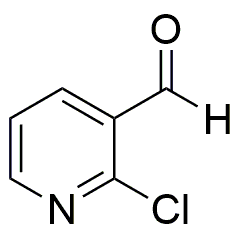2-Chloro-3-pyridinecarboxaldehyde is widely utilized in research focused on:
- Synthesis of Pharmaceuticals: This compound serves as a key intermediate in the synthesis of various pharmaceutical agents, particularly those targeting neurological disorders. Its unique structure allows for the development of novel drug candidates.
- Agricultural Chemicals: It is used in the formulation of agrochemicals, including herbicides and fungicides, enhancing crop protection and yield. This application is crucial for sustainable agriculture practices.
- Organic Synthesis: Researchers employ it in organic synthesis reactions, such as the preparation of heterocyclic compounds. Its reactivity and functional groups make it a valuable building block in organic chemistry.
- Material Science: The compound is explored in the development of advanced materials, including polymers and coatings, due to its ability to modify surface properties and improve durability.
- Analytical Chemistry: It is utilized as a reagent in analytical methods, such as chromatography, helping to identify and quantify other chemical substances effectively.
Informations générales
Propriétés
Sécurité et réglementation
Applications
2-Chloro-3-pyridinecarboxaldehyde is widely utilized in research focused on:
- Synthesis of Pharmaceuticals: This compound serves as a key intermediate in the synthesis of various pharmaceutical agents, particularly those targeting neurological disorders. Its unique structure allows for the development of novel drug candidates.
- Agricultural Chemicals: It is used in the formulation of agrochemicals, including herbicides and fungicides, enhancing crop protection and yield. This application is crucial for sustainable agriculture practices.
- Organic Synthesis: Researchers employ it in organic synthesis reactions, such as the preparation of heterocyclic compounds. Its reactivity and functional groups make it a valuable building block in organic chemistry.
- Material Science: The compound is explored in the development of advanced materials, including polymers and coatings, due to its ability to modify surface properties and improve durability.
- Analytical Chemistry: It is utilized as a reagent in analytical methods, such as chromatography, helping to identify and quantify other chemical substances effectively.
Documents
Fiches de données de sécurité (FDS)
La FDS fournit des informations de sécurité complètes sur la manipulation, le stockage et l’élimination du produit.
Spécifications du produit (PS)
Le PS fournit une description complète des propriétés du produit, notamment sa composition chimique, son état physique, sa pureté et les exigences de stockage. Il détaille également les plages de qualité acceptables et les applications prévues du produit.
Certificats d'analyse (COA)
Recherchez des certificats d'analyse (COA) en saisissant le numéro de lot du produit. Les numéros de lot et de lot se trouvent sur l'étiquette d'un produit, après les mots « Lot » ou « Lot de fabrication ».
Numéro de catalogue
Numéro de lot/série
Certificats d'origine (COO)
Ce certificat d'exploitation confirme le pays dans lequel le produit a été fabriqué, et détaille également les matériaux et composants utilisés et s'il est issu de sources naturelles, synthétiques ou autres sources spécifiques. Ce certificat peut être requis pour les douanes, le commerce et la conformité réglementaire.
Numéro de catalogue
Numéro de lot/série
Fiches de données de sécurité (FDS)
La FDS fournit des informations de sécurité complètes sur la manipulation, le stockage et l’élimination du produit.
DownloadSpécifications du produit (PS)
Le PS fournit une description complète des propriétés du produit, notamment sa composition chimique, son état physique, sa pureté et les exigences de stockage. Il détaille également les plages de qualité acceptables et les applications prévues du produit.
DownloadCertificats d'analyse (COA)
Recherchez des certificats d'analyse (COA) en saisissant le numéro de lot du produit. Les numéros de lot et de lot se trouvent sur l'étiquette d'un produit, après les mots « Lot » ou « Lot de fabrication ».
Numéro de catalogue
Numéro de lot/série
Certificats d'origine (COO)
Ce certificat d'exploitation confirme le pays dans lequel le produit a été fabriqué, et détaille également les matériaux et composants utilisés et s'il est issu de sources naturelles, synthétiques ou autres sources spécifiques. Ce certificat peut être requis pour les douanes, le commerce et la conformité réglementaire.


